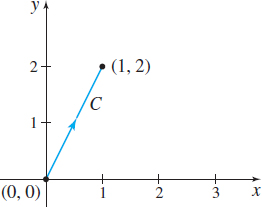EXAMPLE 2Finding the Value of a Line Integral
Find ∫C(x2+y)ds
if C is the line segment from (0,0) to (1,2) and C is expressed using the parametric equations:
- (a) x(t)=t and y(t)=2t,0≤t≤1
- (b) x(t)=sint and y(t)=2sint,0≤t≤π2

Solution The two sets of parametric equations in (a) and (b) are just different ways of representing a part of the line y=2x from (0,0) to (1,2), as shown in Figure 14.
(a) For x(t)=t and y(t)=2t, we have dxdt=1 and dydt=2. The differential ds of the arc length s is ds=√12+22dt=√5dt. Then ∫C(x2+y)ds=↑x=ty=2t∫10(t2+2t)√5dt=√5(t33+t2)]10=4√53
980
(b) For x(t)=sint and y(t)=2sint, we have dxdt=cost and dydt=2cost. Since cost≥0 on 0≤t≤π2, the differential ds of the arc length s is ds=√(dxdt)2+(dydt)2dt=√cos2t+4cos2tdt=√5cos2tdt=√5costdt
Then ∫C(x2+y)ds=↑x=sinty=2sint∫π/20(sin2t+2sint)√5costdt=√5∫π/20(sin2t+2sint)costdt=√5[sin3t3+sin2t]π/20=4√53
the same value found in (a).